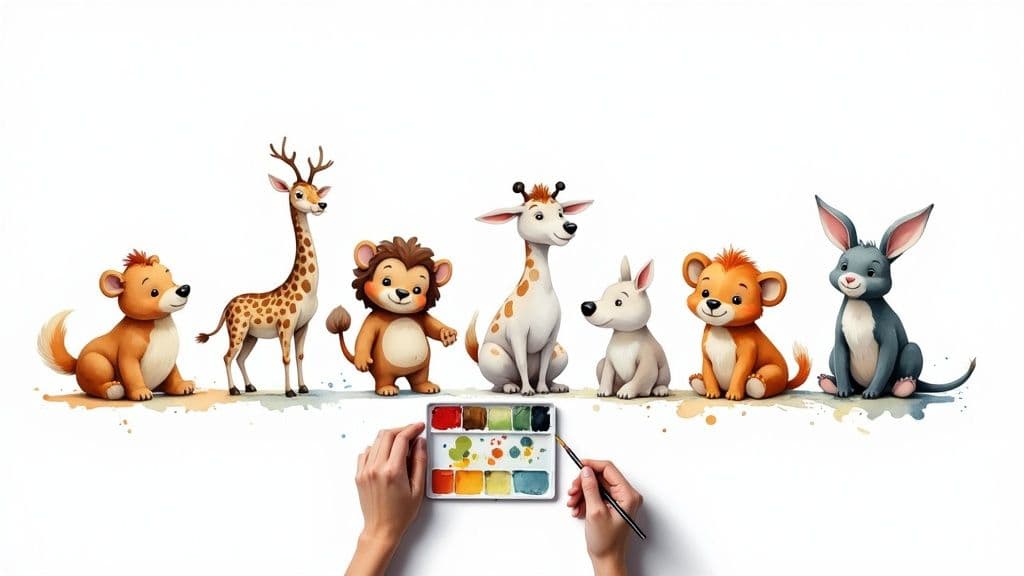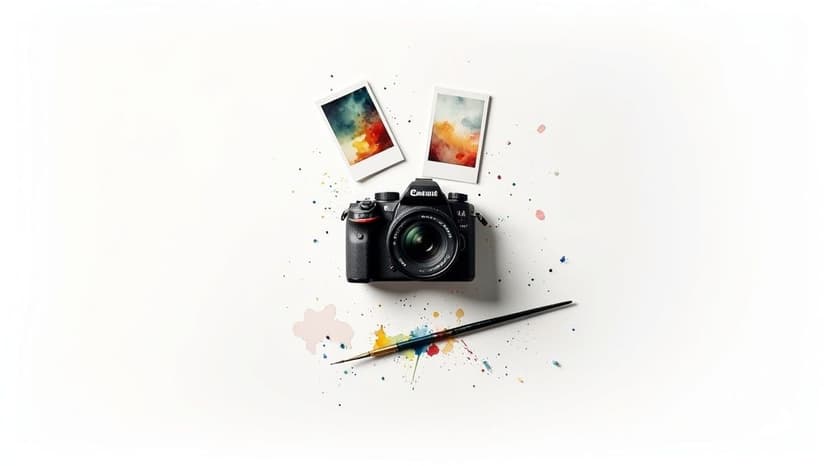
Top sources for copyright free images for websites in 2025
Discover top sources for copyright free images for websites in 2025, with licensing tips, usage guidance, and safe visuals.
Feeling creative? Discover 7 fun and easy cartoon animals to draw, from classic favourites to modern icons. Perfect for aspiring artists!

Instastock Team
October 19, 2025 • 14 min read
Ever seen a beloved cartoon character and thought, 'I wish I could draw that'? Well, you're in the right place! Learning to draw is a rewarding journey, and starting with familiar, simple shapes is the perfect way to build both confidence and skill. This guide isn't about complex anatomy or daunting techniques; it's a celebration of simple lines and iconic forms. We’ve organised a list of classic cartoon animals to draw that are not only fun but also teach fundamental principles of character design, from the power of a simple circle to the impact of an expressive pose.
This curated collection is designed to be your launchpad. Whether you're a budding artist, a content creator looking for inspiration, or just someone seeking a creative outlet, you'll find accessible steps here. Each entry breaks down a famous character into manageable parts, offering practical tips to help you capture their unique charm and personality. For an even wider array of inspiration beyond these classics, you can explore more cartoon drawing ideas to keep your sketchbook full.
So, grab your pencil or stylus, and let's bring some of the most recognisable characters to life on your page. Ready to start sketching?
When you're looking for iconic cartoon animals to draw, there's no better place to start than with the character who practically invented cartoon stardom: Mickey Mouse. Created by Walt Disney and Ub Iwerks, Mickey's design is a masterclass in using simple, appealing shapes to create a timeless and universally recognisable figure. His construction is elegantly simple, relying on circles and ovals, which makes him an excellent subject for artists of all skill levels.
The beauty of drawing Mickey lies in this geometric foundation. His head is a primary circle, with two smaller, perfectly round circles for ears. This simple three-circle silhouette is so powerful it has become a global symbol for Disney itself. Mastering this fundamental structure is the key to capturing his likeness and provides a fantastic exercise in proportion and placement.

Mickey Mouse is an ideal choice for a drawing warm-up or a dedicated practice session because his design teaches the core principles of character creation. The relationship between the size of his head, ears, body, and limbs is a lesson in creating balanced and appealing proportions. From Walt Disney Studios' own animation tutorials to countless fan art interpretations online, Mickey remains a cornerstone of cartoon art education. His enduring popularity ensures that your drawing will be instantly familiar to almost anyone.
To get that classic Disney look, focus on the details that make Mickey so distinctive. Follow these specific tips to bring him to life on your page:
For artists interested in how minimalist design can convey maximum personality, Snoopy is one of the most brilliant cartoon animals to draw. Created by Charles M. Schulz, the world-famous beagle from the Peanuts comic strip is a masterclass in the power of simple, confident lines. His design rejects complexity in favour of elegant curves and minimal detail, proving that you don't need intricate features to create a character full of imagination, wit, and charm.
The brilliance of drawing Snoopy is rooted in his distinctive, peanut-shaped form. Unlike characters built from perfect circles, Snoopy's construction flows with organic, curved lines that give him a unique and flexible silhouette. This makes him a fantastic subject for artists learning to express emotion and movement through posture and form rather than complex facial expressions. Mastering his simple shape is a valuable exercise in achieving expressiveness with an economy of line.

Snoopy is an ideal character for practising line control and understanding how form communicates personality. His many alter egos, from the Flying Ace to Joe Cool, are all achieved through subtle changes in pose and simple props, teaching artists how to imply a story with just a few well-placed lines. Because his design is so fundamentally simple, it encourages a focus on the core principles of character appeal and movement, making it a rewarding challenge for beginners and a fun warm-up for seasoned illustrators. His simple form shares some principles with other popular cartoon breeds; for another fun take, you can learn more about drawing a cartoon corgi.
To capture the iconic look of Schulz's beloved beagle, focus on the clean lines and shapes that define him. Follow these specific tips to bring his imaginative spirit to your drawing:
For those looking to inject personality and attitude into their work, Bugs Bunny is one of the most essential cartoon animals to draw. This iconic Looney Tunes star, popularised by legendary animators like Tex Avery and Chuck Jones, is a masterclass in expressive character design. His construction combines simple, fluid shapes with exaggerated proportions to create a figure that is instantly recognisable and brimming with confidence.
Drawing Bugs is a fantastic way to learn about conveying emotion through posture and facial features. His design, from the towering ears to the oversized feet and sly grin, is built to be dynamic and flexible. This makes him a rewarding challenge for artists who want to move beyond static poses and explore the principles of character acting through illustration.
Bugs Bunny is an excellent subject because his design teaches the power of exaggeration and attitude in character art. Unlike more symmetrically designed characters, Bugs's appeal comes from his nonchalant lean, clever expressions, and dynamic, lanky build. Learning to draw him helps artists understand how to use body language to tell a story and imbue their creations with a distinct personality. This makes him a cornerstone for anyone studying character design, and his playful nature makes the process fun and engaging. His unique design also serves as a great foundation for more creative interpretations, such as this Bionic Bunny in a Steampunk Outfit.
To capture that classic Warner Bros. flair, you need to focus on the elements that give Bugs his signature "What's up, doc?" swagger. Follow these specific tips to bring his personality to your page:
Stepping into the world of kawaii, Hello Kitty offers a masterclass in achieving maximum cuteness with minimal design. Created by Sanrio, this beloved character proves that you don't need complex details to create one of the most recognisable cartoon animals to draw. Her design is a brilliant exercise in the power of simplification, relying on a clean, rounded form and a few key features to create an icon that's both easy to sketch and universally adored.
The elegance of drawing Hello Kitty is rooted in her geometric purity and deliberate simplicity. Her head is a soft, rounded shape, her features are placed with perfect precision, and her signature bow adds a pop of personality. The deliberate lack of a mouth is a core design choice, allowing people to project their own feelings onto her. This makes her an excellent subject for beginners wanting to understand character appeal and for seasoned artists exploring the "less is more" philosophy.

Hello Kitty is an ideal character for practising precision and clean line work. Her design teaches how powerful symmetry and proportion are in creating a balanced and appealing figure. Mastering her form helps develop a steady hand and an eye for placement, skills that are fundamental to all forms of illustration. Her global presence in everything from fashion to merchandise ensures that your drawing will be instantly familiar, making it a rewarding piece to create and share. For more inspiration on drawing feline characters, you can see how artists are creating beautiful images of a cat with a squirrel.
To capture that authentic Sanrio charm, focus on the clean, deliberate details that define her. Follow these specific tips to bring her to life on your page:
When exploring cartoon animals to draw, tackling a big cat like Simba offers a fantastic lesson in blending realistic anatomy with expressive, stylised features. Inspired by the masterful animation of Disney's The Lion King, drawing a cartoon lion challenges artists to capture the power and grace of a real animal while infusing it with personality and emotion. This approach is perfect for learning how to simplify complex forms without losing their essence.
The brilliance of drawing a character like Simba lies in this balance. The design, spearheaded by animators like Glen Keane and Aaron Blaise, honours the structure of a real lion cub but simplifies it into appealing, easy-to-digest shapes. The head is a foundational circle, but it’s paired with a more structured, boxy muzzle and expressive eyes that convey a huge range of feeling. Mastering this combination of soft curves and strong angles is key to creating a compelling and believable character.
Drawing a cartoon lion is an exceptional exercise for any artist looking to move beyond basic shapes into more character-driven designs. It teaches you how to observe real-world animal anatomy and make deliberate choices about what to exaggerate and what to simplify. You learn to convey strength through posture and innocence through oversized features, like the large head and paws of a cub. This skill is invaluable across all forms of character art, from creating children’s book illustrations to developing your own animated personalities.
To give your lion that classic, animated feel, focus on the structural details that define the character. Follow these specific tips to bring your big cat to life on the page:
When exploring cartoon animals to draw, venturing into the world of fantasy creatures grounded in real-world traits can be incredibly rewarding. Pikachu, the beloved face of the Pokémon franchise, is a perfect example. Designed by Ken Sugimori, Pikachu’s design brilliantly merges the familiar features of a mouse or rodent with dynamic, imaginative elements, creating a character that is both cute and powerful. Its construction is based on soft, rounded shapes, making it an accessible yet engaging subject for artists.
The genius of Pikachu's design is its harmonious blend of simplicity and unique details. The body is essentially a soft, pear-shaped oval, topped with a round head and long, expressive ears. This foundation of simple geometry makes the initial sketch straightforward, but mastering its iconic features, like the lightning-bolt tail and red cheek pouches, provides a fun challenge. Drawing Pikachu is a fantastic exercise in character design, teaching you how to give a simple form a powerful and memorable personality.
Pikachu is an excellent subject for artists looking to practise creating appeal and conveying energy. The character’s design is a masterclass in using exaggerated features to communicate personality. The relationship between its small, stubby limbs and its large, expressive tail teaches artists about creating dynamic silhouettes and a sense of balance. From the official Pokémon games and anime to a massive global community of fan artists, Pikachu is a cornerstone of modern cartoon culture, ensuring your drawing will be instantly recognisable and loved.
To capture that official Pokémon look, focus on the unique details that make Pikachu so appealing. Follow these specific tips to bring the Electric-type Pokémon to life on your page:
Moving from American classics to a beloved icon of Japanese animation, Totoro offers a wonderfully different drawing experience. Created by the legendary Hayao Miyazaki and Studio Ghibli, this gentle forest spirit is a masterclass in organic shapes and creating a character that feels both immense and incredibly soft. His design, a delightful mix of owl, cat, and rabbit traits, is perfect for artists wanting to practise gentle curves and comforting forms.
The appeal of drawing Totoro lies in his simple, huggable silhouette. He is essentially a large, soft egg or teardrop shape, free from the rigid geometric rules of many Western characters. This makes him one of the most forgiving and enjoyable cartoon animals to draw, allowing you to focus on creating texture, warmth, and a sense of gentle magic. Learning to capture Totoro’s presence is a great lesson in minimalist design, where a few well-placed features convey immense personality.
Totoro is an excellent subject for developing a feel for soft, rounded forms and expressing character through subtle details. Unlike characters built on sharp lines and dynamic angles, Totoro teaches the art of the curve and the power of a simple, friendly expression. His design encourages a looser, more organic approach to sketching. Because he is so well-loved, any drawing of him is instantly recognisable and sure to bring a smile to people's faces.
To capture the gentle spirit of this Ghibli icon, focus on his unique shape and understated features. Follow these specific tips to bring him to life on your page:
| Character | Implementation Complexity 🔄 | Resource Requirements ⚡ | Expected Outcomes 📊 | Ideal Use Cases 💡 | Key Advantages ⭐ |
|---|---|---|---|---|---|
| Mickey Mouse | Low (Beginner-friendly circles) 🔄🔄 | Low (Basic shapes, few lines) ⚡⚡ | Recognizable iconic character 📊📊 | Beginner tutorials, basic proportions 💡 | Simple geometric base, adaptable ⭐⭐ |
| Snoopy (Beagle Dog) | Very Low (Minimal lines) 🔄 | Very Low (Few strokes) ⚡⚡⚡ | Expressive with minimal details 📊 | Learning gesture, emotion with simplicity 💡 | Minimalist, forgiving design ⭐⭐ |
| Bugs Bunny (Rabbit) | Moderate (Exaggerated forms) 🔄🔄🔄 | Moderate (More details, dynamic poses) ⚡⚡ | Expressive personality & attitude 📊📊 | Intermediate cartooning, action poses 💡 | Teaches exaggeration & confidence ⭐⭐⭐ |
| Hello Kitty (Cat) | Very Low (Ultra-simple shapes) 🔄 | Very Low (Basic shapes, minimal detail) ⚡⚡⚡ | Cute and iconic design 📊 | Absolute beginners, kawaii style learning 💡 | Maximum cuteness with simplicity ⭐⭐ |
| Simba/Lion (Big Cat) | High (Anatomy and stylization) 🔄🔄🔄🔄 | High (Detailed form, anatomy knowledge) ⚡ | Realistic but stylized animal 📊📊 | Advanced animal drawing, anatomy studies 💡 | Blend of realism and cartoon ⭐⭐⭐⭐ |
| Pikachu (Mouse) | Low to Moderate (Simple shapes with personality) 🔄🔄 | Low to Moderate (Color, distinct features) ⚡⚡ | Appealing fantasy creature 📊📊 | Fantasy character design, color use 💡 | Distinct, recognizable silhouette ⭐⭐ |
| Totoro (Forest Spirit) | Moderate (Organic shapes and details) 🔄🔄🔄 | Moderate (Soft forms, pattern details) ⚡⚡ | Soft and friendly character impact 📊 | Organic design, beginner-intermediate mix 💡 | Blend of animal features, approachable ⭐⭐⭐ |
Congratulations on working through this menagerie of iconic characters! You’ve just taken a fantastic journey through the fundamentals of character design, exploring everything from the simple, powerful circles of Mickey Mouse to the expressive ears of Bugs Bunny and the gentle, rounded form of Totoro. By sketching these famous cartoon animals to draw, you've done more than just copy lines; you've absorbed decades of animation wisdom condensed into accessible shapes and gestures.
The most important takeaway is that every complex character, no matter how famous, is built from a foundation of simple, geometric forms. Realising this demystifies the drawing process and empowers you to see the underlying structure in any character you admire. Whether it was capturing Pikachu’s energetic spirit or Simba’s noble profile, you've practised the art of conveying personality through posture, expression, and silhouette. This is the core skill that separates a simple doodle from a compelling character.
So, what comes next on your artistic adventure? The key is to maintain momentum and build upon the skills you've just practised. Don't let your sketchbook gather dust!
Ultimately, mastering the art of drawing cartoon animals is about consistent practice and joyful experimentation. Each character you've drawn today offers a unique lesson in design, from creating universal appeal to telling a story with a single image. Once your cartoon animals are perfected on paper, you might consider transitioning your creations into digital formats. To take your characters from static images to animated stars, you can explore advanced tools for creating cartoon videos that bring your drawings to life.
Embrace the process, celebrate your progress, and remember that every line you draw is a step forward. The world is full of inspiration, and now you have the foundational skills to capture it. Keep that pencil moving, stay curious, and continue filling your pages with personality and charm.
Ready to see your creative ideas transformed into polished, professional illustrations? Describe your drawing to Instastock and watch as our AI generates stunning, high-quality digital artwork you can use anywhere, licence-free. Visit Instastock to turn your creative spark into a finished masterpiece in seconds.

Discover top sources for copyright free images for websites in 2025, with licensing tips, usage guidance, and safe visuals.

Wondering what is stock photography? This guide explains how it works, decodes confusing licenses, and shows you how to find great images for your projects.

Discover the best sources for royalty free images for commercial use in 2025. Find high-quality images easy to use and perfect for your projects.